CJCR Dress instructions | Section 2 Appearance
Table of contents
- Deportment (2-2-1)
- Principles (2-2-4)
- Hair (2-2-5)
- Body adornment (2-2-8)
- Undergarments (2-2-15)
- Eyeglasses / sunglasses (2-2-17)
- Specific guidance for ceremonial occasions (2-2-18)
- Wear of clothing items (2-2-19)
- Personal appearance (2-2-41)
Deportment
- General. IAW QR (Cadets) 5.20, the deportment and appearance of all cadets, in uniform or when wearing civilian attire, shall on all occasions reflect credit on the CCO and the individual. It is the responsibility and duty of all cadets to ensure that, by their vigilance, actions and example, the policies, regulations and instructions contained herein are adhered to.
- Behaviour. When in uniform, cadets shall conduct themselves in a manner which projects a positive public appearance. Behaviour such as, but not limited to, chewing gum, use of electronic devices while walking, placing hands in pockets, and walking hand in hand, is prohibited.
- Cadet Presence. Cadets in uniform shall be well presented, with footwear cleaned and shone, and uniform cleaned and properly pressed. In particular, buttons, fasteners and zippers shall be kept closed; pockets shall not be bulged; items such as personal mobile devices, portable electronics, glasses, glass cases, sunglasses, pens, pencils, key rings, or paper shall not be visibly extended, protrude from pockets, or be suspended from waist belts; headphones shall not be worn; and ear buds may only be worn when travelling on transport. Cadets wearing civilian clothes during cadet activities shall dress and conduct themselves in a manner that reflects positively as members of the CCO.
Principles
- While ceremonial standards may apply in certain circumstance, the CJCR policy on appearance is premised on three principles: safety, inclusion, and a reflection of changing societal norms. These principles, listed in priority, are defined as:
- Safety. All members of the CCO are responsible to ensure that the safety of personnel is not compromised.
- Inclusion. The practice of providing equal access to opportunities and resources, where all members have a sense of belonging and are encouraged to be their authentic selves. Leaders are to treat all personnel under their care with dignity and respect. In some cases, additional accommodations may be needed. Specific accommodations in respect of this policy are regulated under DAOD 5516-3, Religious or Spiritual Accommodation.
- Societal Norms. The CCO is a microcosm of Canadian society. As much as is possible, policies applying to CCO members, including standards of dress, should reflect the changing norms in Canadian society. This will welcome a more diverse group of CCO members, which will benefit the CCO as diversity is a known force multiplier.
Hair
- Hair shall not prevent the proper wear of a military headdress or protective equipment. Hair must be worn so that without a headdress the cadet’s face is visible. Full or partial shaving of hair on the head is permitted. Colouring of hair is permitted. The wearing of wigs, dreadlocks, or hair extensions is permitted. Long hair is permitted but must be secured accordingly when extending below the top / ridge of the shoulder in such a manner to prevent hair from covering the face. Acceptable accessories to secure hair include, but are not limited to, clips, barrettes, bobby pins, fabric elastics, elastic bands, and hair nets.
- In cases where safety may be compromised, or where a hairstyle that is associated with a cultural, religious, or spiritual belief that does not align with this policy, cadets are to refer to DAOD 5516-3, Religious or Spiritual Accommodation and Section 3 of this chapter.
- Facial Hair. All styles of facial hair and sideburns are authorized. Facial hair may be braided / ponytail style and coloured. Accessories to secure facial hair include but are not limited to: barrettes, bobby pins, fabric elastics, elastic bands, and hair nets.
Body adornment
- Jewellery. The wearing of jewellery is permitted in uniform however cadets must not:
- wear jewellery over uniform items;
- while in uniform, have ear piercings and ear gauges / spacers of more than 2.5 cm diameter or diagonal measurement (dependent on the activity whether for ceremonial or safety reasons, the number of earrings may be restricted);
- wear jewellery in piercings which are normally covered by uniforms if they pose a risk of injury;
- wear jewellery that impairs the cadets’ safety or ability to perform their duties;
- wear jewellery that a cadet knows, or ought reasonably to know, are connected with criminal activities (e.g., criminal gangs), that promote and / or express, on the basis of a prohibited ground of discrimination as defined in the Canadian Human Rights Act (CHRA), the following: hatred, violence, discrimination, or harassment; or
- wear jewellery that a cadet knows, or ought to know, promote and / or express: racism, sexism, misogyny, misandry, xenophobia, homophobia, ableism, or sexually explicit material.
- Rings. There are no limits to the number of rings a cadet can wear in uniform (dependent on the activity whether for ceremonial or safety reasons, the number of rings may be restricted);
- Earrings. Cadets in uniform may have multiple ear piercings as well as ear gauges / spacers of no more than 2.5 cm square or diameter. (See Figure 2-2-4)
- Nose rings. Cadets in uniform may have a single nose piercing, as associated with a cultural, religious, or spiritual belief. Septum piercings are not permitted, (dependent on the activity whether for ceremonial or safety reasons, the number of earrings may be restricted). (See Figure 2-2-4)
- The only authorized piercing above the shoulders are those on the ears and nose.
- Make-up. Cadets may wear make-up, whether in uniform or civilian clothes. They may wear nail polish, artificial nails, temporary lashes, and eyelash extensions unless it impairs the cadets’ safety or ability to perform their duties. Safety must be considered at all times.
- Tattoos. Tattoos are permitted. However, cadets must not have:
- tattoos that a cadet knows, or ought reasonably to know, are connected with criminal activities (e.g., criminal gangs), tattoos that promote and / or express, on the basis of a prohibited ground of discrimination as defined in the CHRA, the following: hatred, violence, discrimination, or harassment; or
- tattoos that a cadet knows, or ought to know, promote and / or express: racism, sexism, misogyny, misandry, xenophobia, homophobia, ableism, or sexually explicit material.
- tattoos of a cultural nature (such as Inuit face tattoos) shall be allowed.
Undergarments
- Undergarments shall be worn under all orders of dress and shall be of an appropriate colour so as not to be visible through uniform and civilian items of clothing.
- Undershirts may be worn under any order of dress. Undershirts shall be of a solid colour and free of lettering or designs that will show through the uniform shirt. Undershirts shall not be visible at the neck opening or below the sleeves.
Eyeglasses / sunglasses
- Eyeglasses and sunglasses are permitted for wear in all orders of dress.
Specific guidance for ceremonial occasions
- Ceremonial order of dress (C1) shall only be ordered for specific occasions (CO’s parade, Formal parades, ACRs, etc.) C1 shall not be the standard training dress at a corps/squadron. The following amplification is provided for all cadets when in C1 order of dress:
- footwear will be worn as per environment / regiments / branches and corps / squadron dress instructions;
- over garment will be worn as per environments / regiments / branches and corps / squadron dress instructions. Medals are not to be worn on over garment (parka, gabardine, windbreaker);
- hair that extends below the tunic jacket collar shall be secured in one of the following styles:
- in a bun;
- a single braid;
- double braids centred to the back;
- multi braids or locks, be pulled back to the centre of the back or equally positioned along the shoulder blades and secured; or
- when hairstyle or hair type does not allow a cadet to adopt one of the aforementioned hairstyles, the cadet must discuss with the Chain of Command to find a hairstyle that can be secured accordingly.
- Jewellery;
- Rings, a maximum of two rings which are not of costume jewellery nature. Additional rings may only be worn when they indicate professional standing, such as an engineer, or are worn with a wedding band as a single set indicating betrothal or fidelity, e.g., an engagement or an anniversary ring. Rings shall not inhibit the execution of proper arms drill or cause an unsightly bulge in white or black gloves.
- Necklaces and bracelets shall not be visible;
- Piercings. The only piercings authorized are single or single set of stud or single stone earrings (one in each ear) are permitted in the ear lobe(s). These earrings shall not exceed one centimeter square or diameter. Gauges / spacers shall not exceed 2.5 cm in diameter; and
- Plain tie-pins or clips or with a Canadian military/Cadet insignia are permitted.
- Facial make-up, temporary lashes, and eyelashes extensions are permitted; and
- Coloured nail polish and artificial nails are permitted as long as they do not impair the cadet’s ability to perform their duties.
Wear of clothing items
- General. The following paragraphs give instructions for common items, both permanent equipment and optional items.
- Headdress: (see Figure 2-2-5).
- Beret. The beret shall be worn level on the head, with the sweatband above the eyebrows, the badge centred over the left eye, and the crown pulled downward to the right. The break of the sweatband shall be worn centred at the back of the head, with no draw string visible. The colour of the beret shall be:
- Sea Cadets – When authorized in training C5 order of dress – black;
- Air Cadets – When authorized in training C5 order of dress – blue;
- Army Cadets – The dark green beret shall be worn by Army Cadets unless authorized to wear the headdress of their affiliated unit, to include:
- Armoured – black;
- Artillery, Electrical Engineers, Signals, and Intelligence – blue;
- Regiments of Foot Guards – guards-pattern undress peak caps as optional items, or khaki;
- Rifle Regiments – rifle-pattern undress field service (wedge) caps;
- Airborne – maroon;
- Military Police – scarlet; and
- Highland – glengarry or balmoral.
- Wedge Cap. Worn on the right side of the head, centred front and back, with the front edge of the cap 2.5 cm (1 in) above the right eyebrow. Two Air Force buttons shall be attached in pre-cut holes at the front;
- Sailor’s Cap. (see Figures 2-2-6 through 2-2-8) Worn so that the rim of the cap is 2.5 cm (1 in) above the eyebrow. The front seam is centred directly over the nose. The chin stay shall be sewn inside the cap at the correct length to permit the stay to fit under the chin. It may be worn with Royal Canadian Sea Cadet or corps cap tally. If Royal Canadian Sea Cadet, the centre of the lettering on the cap tally (between the “I” and “A” of the word “CANADIAN”) should be in line with the front cap seam. For the corps name, fold in half from the “R” (RCSC) to the last letter of the corps name, and centre to line up with the front cap seam. It is tied in a neat bow, not more than 7.5 cm (about 3 in) and not less than 5 cm (about 2 in) across, the ends being of equal length. The bow is to be centred on the left ear vents. The chin stay shall be worn down by cadets wearing webbing if parading as a member of a band, guard or colour party;
- Sea Cadet Ball Cap. Worn square on the head with the sweatband 2.5 cm (1 in) above the eyebrows. The brim of the cap shall not have excessive or exaggerated curve and is not to be folded or creased down the centre. The lettering is to be 1.3 cm (1/2 in) gold coloured thread embroidery, displaying:
- “RCSCC” and corps name (e.g., RCSCC LIGHTHOUSE), and corps numerical designator (e.g., 987) on the front panel in capital block lettering, and no other lettering or graphic is authorized; or
- “HMCS LIGHTHOUSE” on the front panel in capital block lettering, and no other lettering or graphic is authorized.
- Air Cadet Ball Cap. Worn square on the head with the sweatband 2.5 cm (1 in) above the eyebrows. The brim of the cap shall not have excessive or exaggerated curve and is not to be folded or creased down the centre.
- Wide-Brimmed Tan Summer Hat. Worn by cadets when undergoing training activities for which the regular headdress is unsuitable;
- Toque. Worn as an alternative winter headdress. Toques shall be worn flush against the top of the head and turned up once to show either a 7.5 cm (3 in) or a 10 cm (4 in) fold according to the design of the toque, with the lower edge of the fold 2.5 cm (1 in) above the eyebrows. The insignia is centered directly over the nose. According to the severity of the weather, the toque may be:
- worn up, square on the head and slightly angled towards the back; or
- pulled down at the sides and back to cover the ears.
- Turban / Patka. Detail pertaining to the turban / patka are detailed in Section 3;
- Kippah. Details pertaining to kippah are found in Section 3;
- Hijab. Details pertaining to the hijab are found in Section 3; and
- Kippot. Details pertaining to the kippot are found in Section 3.
- Beret. The beret shall be worn level on the head, with the sweatband above the eyebrows, the badge centred over the left eye, and the crown pulled downward to the right. The break of the sweatband shall be worn centred at the back of the head, with no draw string visible. The colour of the beret shall be:
- Jackets. Sleeves shall be roll-pressed with no creases. Jackets shall be worn fully buttoned-up except for the top button. This uniform item is informally referred to as a tunic.
- Jacket Belts. Worn so that the excess of the belt, once attached, is on the left side of the buckle. The buckle shall be adjusted so that it is centred on the buttons of the jacket. Belts shall not exceed more than 5 cm (about 2 in) past the first permanent loop of the jacket. Exceedingly long belts shall not be tucked in but shall be exchanged for a size that fits.
- Trousers. Shall be worn as follows:
- with the trousers belt;
- pressed to have a crease down the front and back centre of each leg; and
- the length of the trousers should extend to the third eyelet from the bottom of the cadet ankle boot.
- Belt for Trousers. The issued narrow black web belt with brass buckle shall be worn with the trousers. Belts should be worn so the excess belt protrudes from the buckle toward the wearer’s left. The buckle will be adjusted so the excess material is not visible and will give a ‘brass-on-brass’ look. Buckles with elemental / corps / squadron / CTC badges are authorized for wear with the uniform.
- Sea Cadet Lanyards. Worn under the collar, with the knot placed at the second button from the top, while the remainder of the lanyard loops around and is tucked into the inner corner of the left breast pocket with slack of bight of the lanyard hanging 8 cm (about 3-1/8 in) below the top of the pocket.
- Shirt. Worn with or without tie. Rank slip-ons shall be worn with the shirt. Cadets may wear open neck with jacket. When worn open neck, shirt collar shall be worn over jacket collar.
- Field Training Shirt. Worn with the sleeves rolled up or down and rank slip-ons shall be worn. Sleeves, when rolled up, will be sharp, flat, and neatly rolled past the elbow. No draw strings will be visible. Name tape may be worn.
- Field Training Pants. Shall be worn as follows:
- with trousers belt; and
- with pants legs bloused over the multi-purpose boot.
- Sea Training Shirt. Worn with the sleeves rolled up or down and rank slip-ons shall be worn. Sleeves, when rolled up, will be sharp, flat, and neatly rolled past the elbow. Name tape or Name Tag may be worn.
- T-Shirt, Environmental (Black / Green / Blue). The t-shirt shall be worn under the Sea Training Uniform (STU), Field Training Uniform (FTU) and Flight Suit (C5B).
- Rank slip-ons. Shall be worn with the following:
- shirt;
- the all-season coat (worn on both the liner and the exterior coat);
- the flight suit at the flying site;
- sea training uniform (STU); and
- field training uniform (FTU).
- Insignia Shoulder Title. Shall be worn on both sleeves of the jacket.
- Necktie. Shall be knotted neatly using a Windsor knot, (see Figure 2-2-9) or a Four in Hand knot, (see Figure 2-2-9-b) and be kept tight. Neutral, formal, or colour matching tiepins or clips may be worn.
- Socks. Grey wool socks may be worn with boots and running shoes. Cadets may elect to wear their own personal socks, grey or black, wool, cotton, or nylon, in lieu of the issued grey wool socks. Socks shall not be rolled down.
- Boots Ankle. (see Figure 2-2-10). Ankle boots shall be laced across horizontally from side to side. Boots shall be clean and always shone. They will not be modified with any type of metal cleats, hobnails, or other metal attachments to heel or sole.
- Multi-Purpose Boot. (see Figure 2-2-10). Intended for wear as environmental dress with the Cadet FTU. Multi-purpose boots shall be cross laced and always kept clean. They may be blackened with boot polish but shall not be shone.
- Running Shoes. Worn with personal or issued sports clothing. As ordered by the corps / squadron / CTC CO, may be worn in any order of training or operational dress provided that the footwear is considered suitable for the type of activity. May be worn with ceremonial or service dress in lieu of boots only if the facility owner does not allow black soled boots.
- All-Season Coat. Worn IAW the following:
- may be worn year-round when weather conditions dictate;
- the liner and the exterior coat may be worn separately or as a set;
- when worn, the zipper and dome fasteners shall be fully closed to the second from the top button; and
- the liner alone shall not be worn for ceremonial events in public.
- Gloves. Worn, when ordered by the training establishment CO, or as required during outdoor winter dress.
- Accessories
- Backpacks, laptop cases, briefcases, purses / handbags
- when carried as a shoulder-bag, the strap shall be suspended from the left shoulder;
- when carried as a messenger bag (cross body), the strap shall be suspended from the right shoulder;
- when carried, civilian-pattern bags / cases shall be of any solid colour. Accessories of any type shall not be attached to the exterior of the bag / case / backpack; and
- when carried, they shall be held in the left hand or suspended over the left shoulder. Backpacks may be worn over both shoulders.
- Umbrella. Umbrellas may be carried. They shall be of any dark solid colour.
- Backpacks, laptop cases, briefcases, purses / handbags
Personal appearance
Deportment
- General. IAW QR (Cadets) 5.20, the deportment and appearance of all cadets, in uniform or when wearing civilian attire, shall on all occasions reflect credit on the CCO and the individual. It is the responsibility and duty of all cadets to ensure that, by their vigilance, actions and example, the policies, regulations and instructions contained herein are adhered to.
- Behaviour. When in uniform, cadets shall conduct themselves in a manner which projects a positive public appearance. Behaviour such as, but not limited to, chewing gum, use of electronic devices while walking, placing hands in pockets, and walking hand in hand, is prohibited.
- Cadet Presence. Cadets in uniform shall be well presented, with footwear cleaned and shone, and uniform cleaned and properly pressed. In particular, buttons, fasteners and zippers shall be kept closed; pockets shall not be bulged; items such as personal mobile devices, portable electronics, glasses, glass cases, sunglasses, pens, pencils, key rings, or paper shall not be visibly extended, protrude from pockets, or be suspended from waist belts; headphones shall not be worn; and ear buds may only be worn when travelling on transport. Cadets wearing civilian clothes during cadet activities shall dress and conduct themselves in a manner that reflects positively as members of the CCO.
Principles
- While ceremonial standards may apply in certain circumstance, the CJCR policy on appearance is premised on three principles: safety, inclusion, and a reflection of changing societal norms. These principles, listed in priority, are defined as:
- Safety. All members of the CCO are responsible to ensure that the safety of personnel is not compromised.
- Inclusion. The practice of providing equal access to opportunities and resources, where all members have a sense of belonging and are encouraged to be their authentic selves. Leaders are to treat all personnel under their care with dignity and respect. In some cases, additional accommodations may be needed. Specific accommodations in respect of this policy are regulated under DAOD 5516-3, Religious or Spiritual Accommodation.
- Societal Norms. The CCO is a microcosm of Canadian society. As much as is possible, policies applying to CCO members, including standards of dress, should reflect the changing norms in Canadian society. This will welcome a more diverse group of CCO members, which will benefit the CCO as diversity is a known force multiplier.
Hair
- Hair shall not prevent the proper wear of a military headdress or protective equipment. Hair must be worn so that without a headdress the cadet’s face is visible. Full or partial shaving of hair on the head is permitted. Colouring of hair is permitted. The wearing of wigs, dreadlocks, or hair extensions is permitted. Long hair is permitted but must be secured accordingly when extending below the top / ridge of the shoulder in such a manner to prevent hair from covering the face. Acceptable accessories to secure hair include, but are not limited to, clips, barrettes, bobby pins, fabric elastics, elastic bands, and hair nets.
- In cases where safety may be compromised, or where a hairstyle that is associated with a cultural, religious, or spiritual belief that does not align with this policy, cadets are to refer to DAOD 5516-3, Religious or Spiritual Accommodation and Section 3 of this chapter.
- Facial Hair. All styles of facial hair and sideburns are authorized. Facial hair may be braided / ponytail style and coloured. Accessories to secure facial hair include but are not limited to: barrettes, bobby pins, fabric elastics, elastic bands, and hair nets.
Body adornment
- Jewellery. The wearing of jewellery is permitted in uniform however cadets must not:
- wear jewellery over uniform items;
- while in uniform, have ear piercings and ear gauges / spacers of more than 2.5 cm diameter or diagonal measurement (dependent on the activity whether for ceremonial or safety reasons, the number of earrings may be restricted);
- wear jewellery in piercings which are normally covered by uniforms if they pose a risk of injury;
- wear jewellery that impairs the cadets’ safety or ability to perform their duties;
- wear jewellery that a cadet knows, or ought reasonably to know, are connected with criminal activities (e.g., criminal gangs), that promote and / or express, on the basis of a prohibited ground of discrimination as defined in the Canadian Human Rights Act (CHRA), the following: hatred, violence, discrimination, or harassment; or
- wear jewellery that a cadet knows, or ought to know, promote and / or express: racism, sexism, misogyny, misandry, xenophobia, homophobia, ableism, or sexually explicit material.
- Rings. There are no limits to the number of rings a cadet can wear in uniform (dependent on the activity whether for ceremonial or safety reasons, the number of rings may be restricted);
- Earrings. Cadets in uniform may have multiple ear piercings as well as ear gauges / spacers of no more than 2.5 cm square or diameter. (See Figure 2-2-4)
- Nose rings. Cadets in uniform may have a single nose piercing, as associated with a cultural, religious, or spiritual belief. Septum piercings are not permitted, (dependent on the activity whether for ceremonial or safety reasons, the number of earrings may be restricted). (See Figure 2-2-4)
- The only authorized piercing above the shoulders are those on the ears and nose.
- Make-up. Cadets may wear make-up, whether in uniform or civilian clothes. They may wear nail polish, artificial nails, temporary lashes, and eyelash extensions unless it impairs the cadets’ safety or ability to perform their duties. Safety must be considered at all times.
- Tattoos. Tattoos are permitted. However, cadets must not have:
- tattoos that a cadet knows, or ought reasonably to know, are connected with criminal activities (e.g., criminal gangs), tattoos that promote and / or express, on the basis of a prohibited ground of discrimination as defined in the CHRA, the following: hatred, violence, discrimination, or harassment; or
- tattoos that a cadet knows, or ought to know, promote and / or express: racism, sexism, misogyny, misandry, xenophobia, homophobia, ableism, or sexually explicit material.
- tattoos of a cultural nature (such as Inuit face tattoos) shall be allowed.
Undergarments
- Undergarments shall be worn under all orders of dress and shall be of an appropriate colour so as not to be visible through uniform and civilian items of clothing.
- Undershirts may be worn under any order of dress. Undershirts shall be of a solid colour and free of lettering or designs that will show through the uniform shirt. Undershirts shall not be visible at the neck opening or below the sleeves.
Eyeglasses / sunglasses
- Eyeglasses and sunglasses are permitted for wear in all orders of dress.
Specific guidance for ceremonial occasions
- Ceremonial order of dress (C1) shall only be ordered for specific occasions (CO’s parade, Formal parades, ACRs, etc.) C1 shall not be the standard training dress at a corps/squadron. The following amplification is provided for all cadets when in C1 order of dress:
- footwear will be worn as per environment / regiments / branches and corps / squadron dress instructions;
- over garment will be worn as per environments / regiments / branches and corps / squadron dress instructions. Medals are not to be worn on over garment (parka, gabardine, windbreaker);
- hair that extends below the tunic jacket collar shall be secured in one of the following styles:
- in a bun;
- a single braid;
- double braids centred to the back;
- multi braids or locks, be pulled back to the centre of the back or equally positioned along the shoulder blades and secured; or
- when hairstyle or hair type does not allow a cadet to adopt one of the aforementioned hairstyles, the cadet must discuss with the Chain of Command to find a hairstyle that can be secured accordingly.
- Jewellery;
- Rings, a maximum of two rings which are not of costume jewellery nature. Additional rings may only be worn when they indicate professional standing, such as an engineer, or are worn with a wedding band as a single set indicating betrothal or fidelity, e.g., an engagement or an anniversary ring. Rings shall not inhibit the execution of proper arms drill or cause an unsightly bulge in white or black gloves.
- Necklaces and bracelets shall not be visible;
- Piercings. The only piercings authorized are single or single set of stud or single stone earrings (one in each ear) are permitted in the ear lobe(s). These earrings shall not exceed one centimeter square or diameter. Gauges / spacers shall not exceed 2.5 cm in diameter; and
- Plain tie-pins or clips or with a Canadian military/Cadet insignia are permitted.
- Facial make-up, temporary lashes, and eyelashes extensions are permitted; and
- Coloured nail polish and artificial nails are permitted as long as they do not impair the cadet’s ability to perform their duties.
Wear of clothing items
- General. The following paragraphs give instructions for common items, both permanent equipment and optional items.
- Headdress: (see Figure 2-2-5).
- Beret. The beret shall be worn level on the head, with the sweatband above the eyebrows, the badge centred over the left eye, and the crown pulled downward to the right. The break of the sweatband shall be worn centred at the back of the head, with no draw string visible. The colour of the beret shall be:
- Sea Cadets – When authorized in training C5 order of dress – black;
- Air Cadets – When authorized in training C5 order of dress – blue;
- Army Cadets – The dark green beret shall be worn by Army Cadets unless authorized to wear the headdress of their affiliated unit, to include:
- Armoured – black;
- Artillery, Electrical Engineers, Signals, and Intelligence – blue;
- Regiments of Foot Guards – guards-pattern undress peak caps as optional items, or khaki;
- Rifle Regiments – rifle-pattern undress field service (wedge) caps;
- Airborne – maroon;
- Military Police – scarlet; and
- Highland – glengarry or balmoral.
- Wedge Cap. Worn on the right side of the head, centred front and back, with the front edge of the cap 2.5 cm (1 in) above the right eyebrow. Two Air Force buttons shall be attached in pre-cut holes at the front;
- Sailor’s Cap. (see Figures 2-2-6 through 2-2-8) Worn so that the rim of the cap is 2.5 cm (1 in) above the eyebrow. The front seam is centred directly over the nose. The chin stay shall be sewn inside the cap at the correct length to permit the stay to fit under the chin. It may be worn with Royal Canadian Sea Cadet or corps cap tally. If Royal Canadian Sea Cadet, the centre of the lettering on the cap tally (between the “I” and “A” of the word “CANADIAN”) should be in line with the front cap seam. For the corps name, fold in half from the “R” (RCSC) to the last letter of the corps name, and centre to line up with the front cap seam. It is tied in a neat bow, not more than 7.5 cm (about 3 in) and not less than 5 cm (about 2 in) across, the ends being of equal length. The bow is to be centred on the left ear vents. The chin stay shall be worn down by cadets wearing webbing if parading as a member of a band, guard or colour party;
- Sea Cadet Ball Cap. Worn square on the head with the sweatband 2.5 cm (1 in) above the eyebrows. The brim of the cap shall not have excessive or exaggerated curve and is not to be folded or creased down the centre. The lettering is to be 1.3 cm (1/2 in) gold coloured thread embroidery, displaying:
- “RCSCC” and corps name (e.g., RCSCC LIGHTHOUSE), and corps numerical designator (e.g., 987) on the front panel in capital block lettering, and no other lettering or graphic is authorized; or
- “HMCS LIGHTHOUSE” on the front panel in capital block lettering, and no other lettering or graphic is authorized.
- Air Cadet Ball Cap. Worn square on the head with the sweatband 2.5 cm (1 in) above the eyebrows. The brim of the cap shall not have excessive or exaggerated curve and is not to be folded or creased down the centre.
- Wide-Brimmed Tan Summer Hat. Worn by cadets when undergoing training activities for which the regular headdress is unsuitable;
- Toque. Worn as an alternative winter headdress. Toques shall be worn flush against the top of the head and turned up once to show either a 7.5 cm (3 in) or a 10 cm (4 in) fold according to the design of the toque, with the lower edge of the fold 2.5 cm (1 in) above the eyebrows. The insignia is centered directly over the nose. According to the severity of the weather, the toque may be:
- worn up, square on the head and slightly angled towards the back; or
- pulled down at the sides and back to cover the ears.
- Turban / Patka. Detail pertaining to the turban / patka are detailed in Section 3;
- Kippah. Details pertaining to kippah are found in Section 3;
- Hijab. Details pertaining to the hijab are found in Section 3; and
- Kippot. Details pertaining to the kippot are found in Section 3.
- Beret. The beret shall be worn level on the head, with the sweatband above the eyebrows, the badge centred over the left eye, and the crown pulled downward to the right. The break of the sweatband shall be worn centred at the back of the head, with no draw string visible. The colour of the beret shall be:
- Jackets. Sleeves shall be roll-pressed with no creases. Jackets shall be worn fully buttoned-up except for the top button. This uniform item is informally referred to as a tunic.
- Jacket Belts. Worn so that the excess of the belt, once attached, is on the left side of the buckle. The buckle shall be adjusted so that it is centred on the buttons of the jacket. Belts shall not exceed more than 5 cm (about 2 in) past the first permanent loop of the jacket. Exceedingly long belts shall not be tucked in but shall be exchanged for a size that fits.
- Trousers. Shall be worn as follows:
- with the trousers belt;
- pressed to have a crease down the front and back centre of each leg; and
- the length of the trousers should extend to the third eyelet from the bottom of the cadet ankle boot.
- Belt for Trousers. The issued narrow black web belt with brass buckle shall be worn with the trousers. Belts should be worn so the excess belt protrudes from the buckle toward the wearer’s left. The buckle will be adjusted so the excess material is not visible and will give a ‘brass-on-brass’ look. Buckles with elemental / corps / squadron / CTC badges are authorized for wear with the uniform.
- Sea Cadet Lanyards. Worn under the collar, with the knot placed at the second button from the top, while the remainder of the lanyard loops around and is tucked into the inner corner of the left breast pocket with slack of bight of the lanyard hanging 8 cm (about 3-1/8 in) below the top of the pocket.
- Shirt. Worn with or without tie. Rank slip-ons shall be worn with the shirt. Cadets may wear open neck with jacket. When worn open neck, shirt collar shall be worn over jacket collar.
- Field Training Shirt. Worn with the sleeves rolled up or down and rank slip-ons shall be worn. Sleeves, when rolled up, will be sharp, flat, and neatly rolled past the elbow. No draw strings will be visible. Name tape may be worn.
- Field Training Pants. Shall be worn as follows:
- with trousers belt; and
- with pants legs bloused over the multi-purpose boot.
- Sea Training Shirt. Worn with the sleeves rolled up or down and rank slip-ons shall be worn. Sleeves, when rolled up, will be sharp, flat, and neatly rolled past the elbow. Name tape or Name Tag may be worn.
- T-Shirt, Environmental (Black / Green / Blue). The t-shirt shall be worn under the Sea Training Uniform (STU), Field Training Uniform (FTU) and Flight Suit (C5B).
- Rank slip-ons. Shall be worn with the following:
- shirt;
- the all-season coat (worn on both the liner and the exterior coat);
- the flight suit at the flying site;
- sea training uniform (STU); and
- field training uniform (FTU).
- Insignia Shoulder Title. Shall be worn on both sleeves of the jacket.
- Necktie. Shall be knotted neatly using a Windsor knot, (see Figure 2-2-9) and be kept tight. Neutral, formal, or colour matching tiepins or clips may be worn.
- Socks. Grey wool socks may be worn with boots and running shoes. Cadets may elect to wear their own personal socks, grey or black, wool, cotton, or nylon, in lieu of the issued grey wool socks. Socks shall not be rolled down.
- Boots Ankle. (see Figure 2-2-10). Ankle boots shall be laced across horizontally from side to side. Boots shall be clean and always shone. They will not be modified with any type of metal cleats, hobnails, or other metal attachments to heel or sole.
- Multi-Purpose Boot. (see Figure 2-2-10). Intended for wear as environmental dress with the Cadet FTU. Multi-purpose boots shall be cross laced and always kept clean. They may be blackened with boot polish but shall not be shone.
- Running Shoes. Worn with personal or issued sports clothing. As ordered by the corps / squadron / CTC CO, may be worn in any order of training or operational dress provided that the footwear is considered suitable for the type of activity. May be worn with ceremonial or service dress in lieu of boots only if the facility owner does not allow black soled boots.
- All-Season Coat. Worn IAW the following:
- may be worn year-round when weather conditions dictate;
- the liner and the exterior coat may be worn separately or as a set;
- when worn, the zipper and dome fasteners shall be fully closed to the second from the top button; and
- the liner alone shall not be worn for ceremonial events in public.
- Gloves. Worn, when ordered by the training establishment CO, or as required during outdoor winter dress.
- Accessories
- Backpacks, laptop cases, briefcases, purses / handbags
- when carried as a shoulder-bag, the strap shall be suspended from the left shoulder;
- when carried as a messenger bag (cross body), the strap shall be suspended from the right shoulder;
- when carried, civilian-pattern bags / cases shall be of any solid colour. Accessories of any type shall not be attached to the exterior of the bag / case / backpack; and
- when carried, they shall be held in the left hand or suspended over the left shoulder. Backpacks may be worn over both shoulders.
- Umbrella. Umbrellas may be carried. They shall be of any dark solid colour.
- Backpacks, laptop cases, briefcases, purses / handbags
Personal appearance
Figure 2-2-1 – Personal Appearance |
|
|---|---|
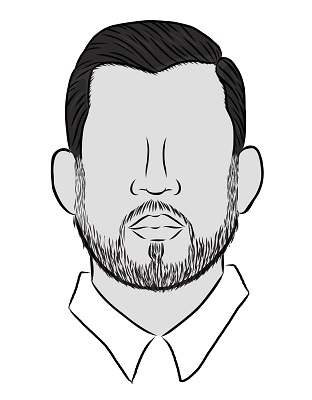 beard |
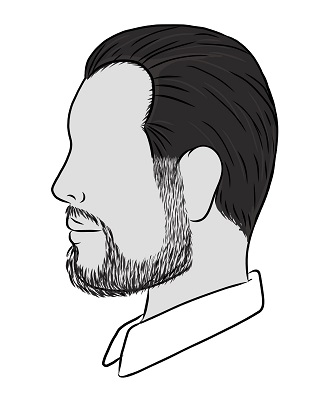 beard from profile |
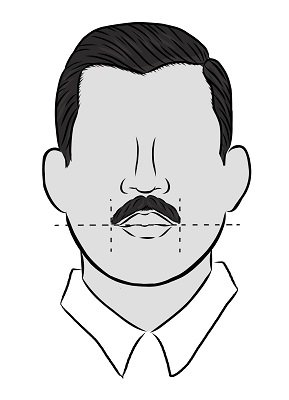 moustache moustache |
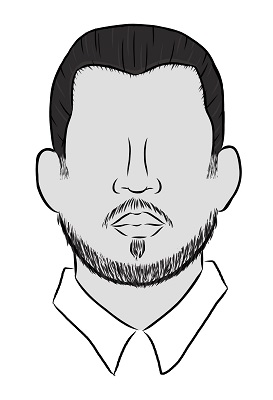 facial hair facial hair |
Figure 2-2-2 – Personal Appearance |
|
|---|---|
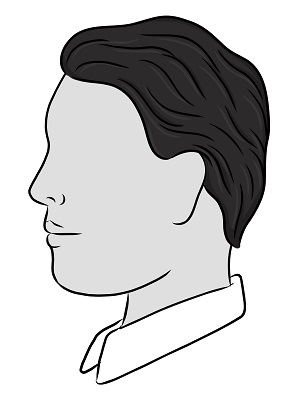 short hair from profile |
 ponytail from profile |
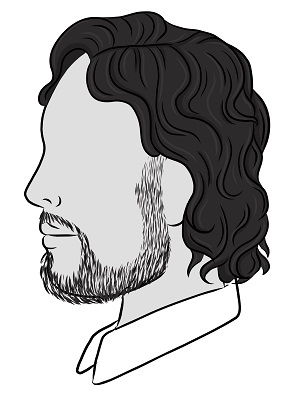 collar length hair from profile |
 bun from profile |
Figure 2-2-3 – Personal Appearance (hair styles) |
|
|---|---|
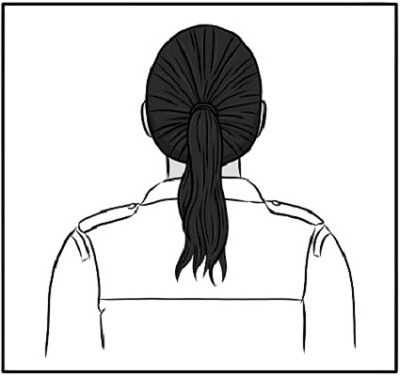 ponytail |
 ponytail from profile |
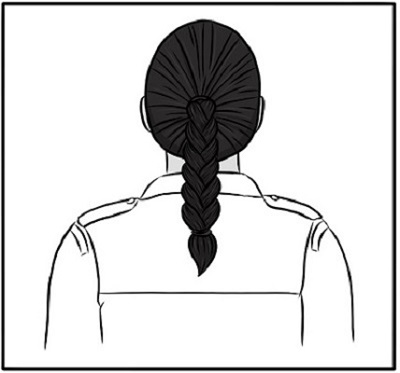 single braid |
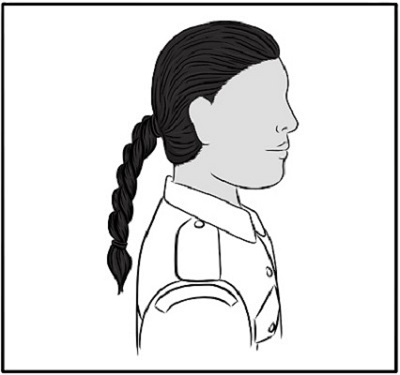 single braid from profile |
 double braids |
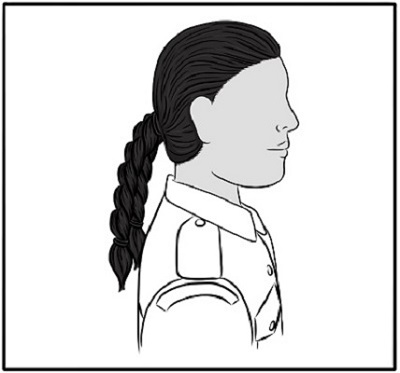 double braids from profile |
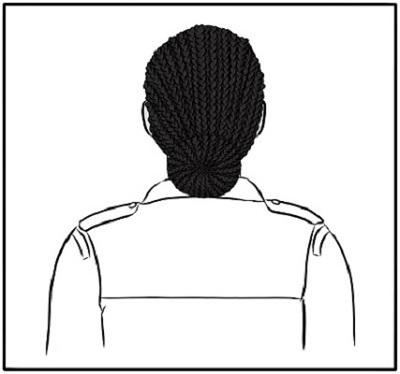 multi-braids (bun) |
 multi-braids (bun) from profile |
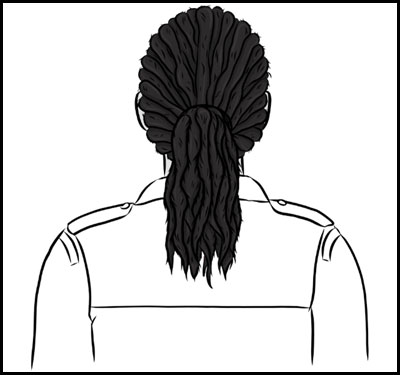 multi-braids (ponytail) |
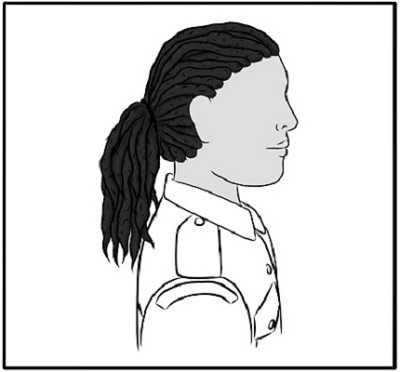 multi-braids (ponytail) from profile |
Figure 2-2-4 - Personal Appearance |
|
|---|---|
 single ear piercing |
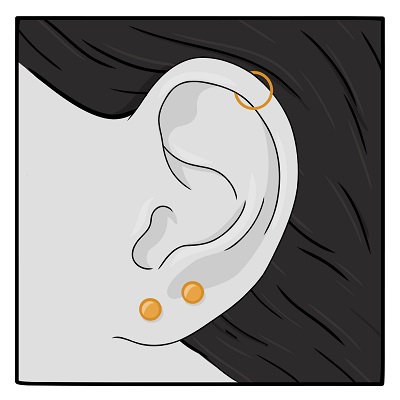 multiple ear piercings |
 2.5 cm spacer 2.5 cm spacer |
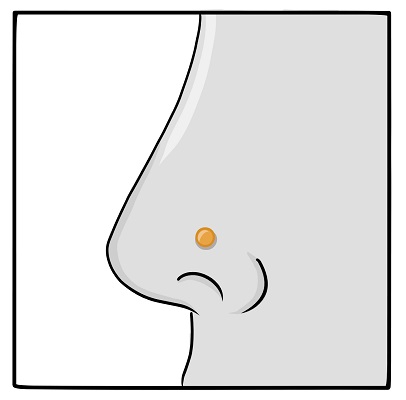 single nose piercing |
Figure 2-2-5 – Headdress |
||
|---|---|---|
 Sailor’s Cap - Sea |
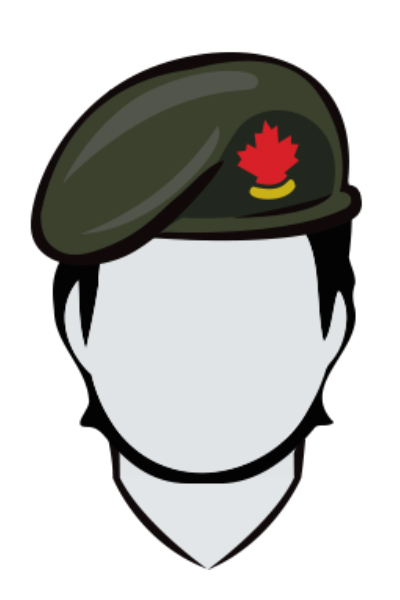 Beret - Common |
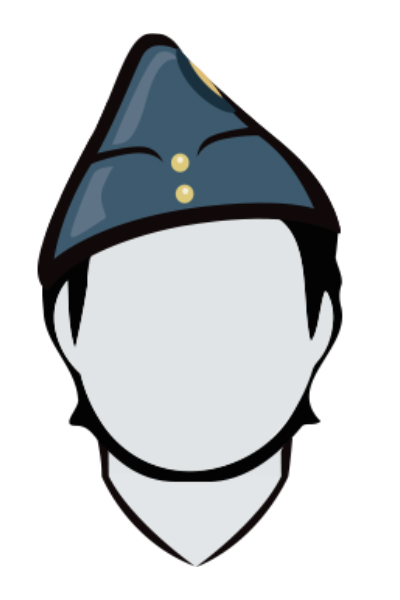 Wedge - Air |
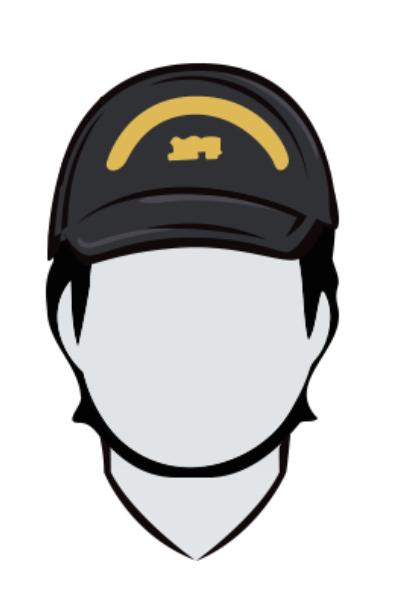 Ball Cap – Sea and Air |
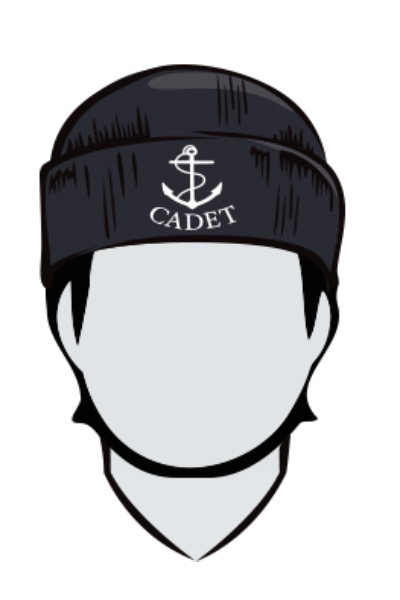 Toque - Common |
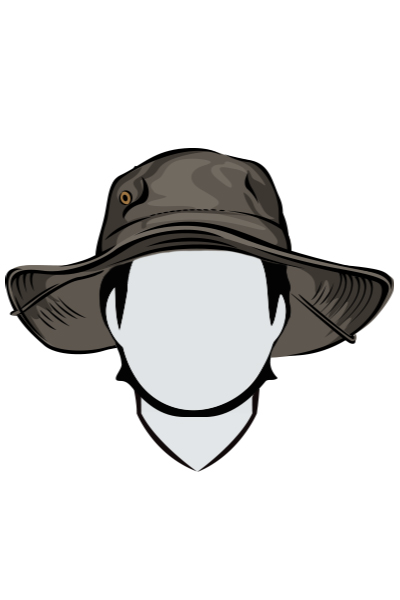 Wide-Brimmed Tan Summer Hat - Common |
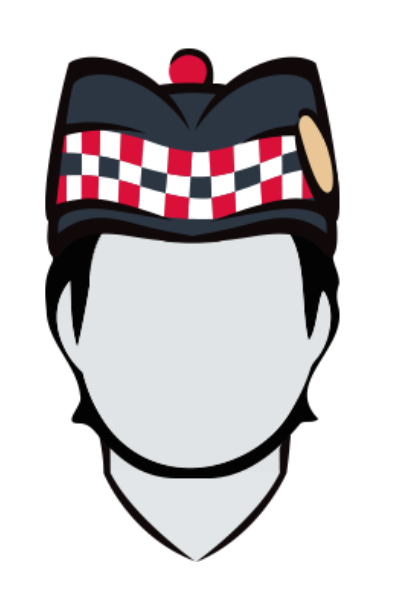 Glengarry - Sea and Army |
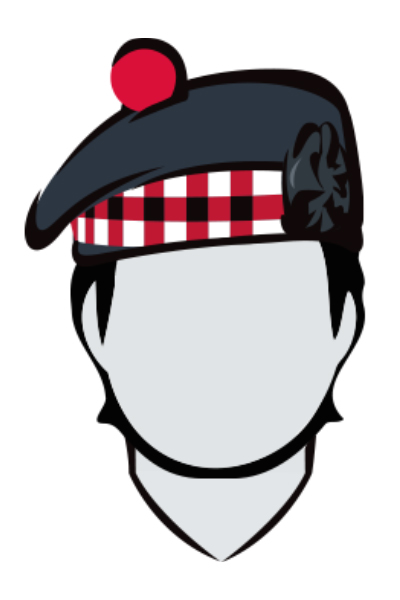 Balmoral - Army |
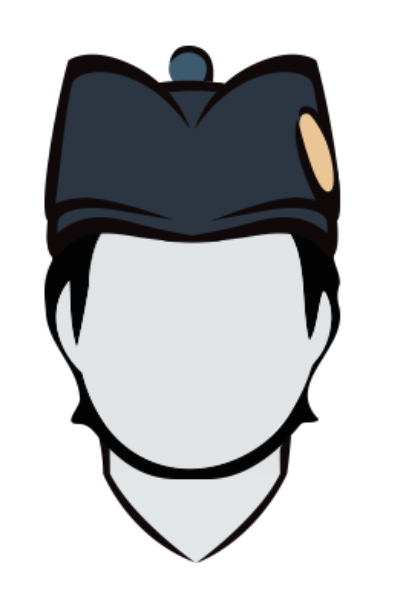 Glengarry - Air |
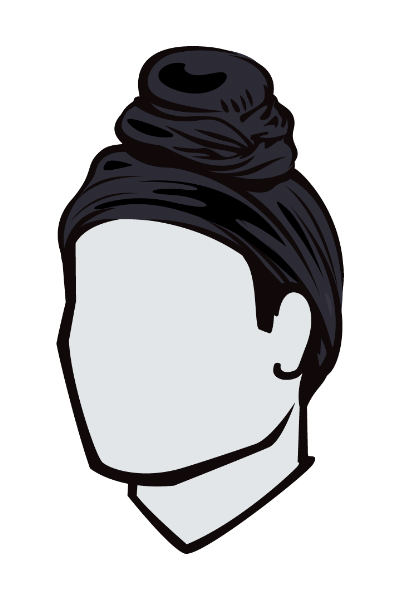 Patka - Common |
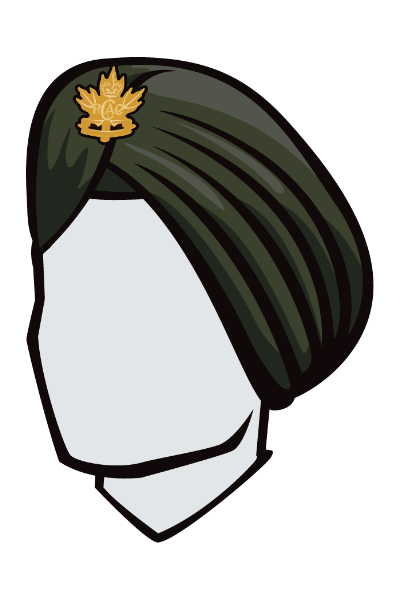 Turban - Common |
 Hijab - Common |
Figure 2-2-6 - How to Tie a Cap Tally, Step 1 |
||
|---|---|---|
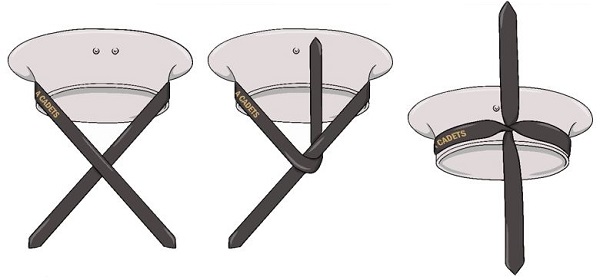 |
||
Step 1: After first lining up the lettering on the cap tally IAW Chapter 2, Section 2, Paragraph 17 c, tie an overhand knot directly under the left-hand seam of the cap. |
Figure 2-2-7 – How to Tie a Cap Tally, Step 2 |
|
|---|---|
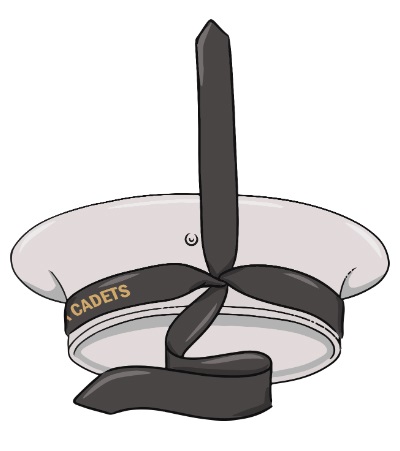 |
Step 2: Form a bight in the bottom tail. |
Figure 2-2-8 - How to Tie a Cap Tally, Steps 3-5 |
|
|---|---|
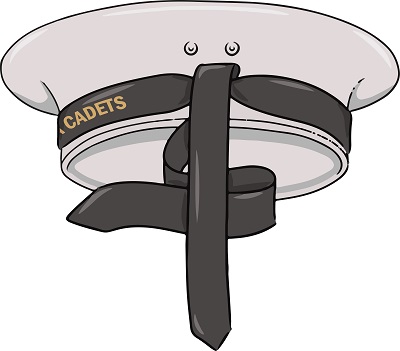 |
Step 3: Pass the upper tail over the bight formed by the bottom tail. |
 |
Step 4: Pass the upper tail around and behind the bight and then through the formed loop. |
 |
Step 5: Pull tight and ensure that it is straight, centred, and not more than 7.5 cm and not less than 5 cm across, the ends being of equal length. Cut off excess tails even with the loops. |
Figure 2-2-9 - Necktie – Windsor Knot |
|---|
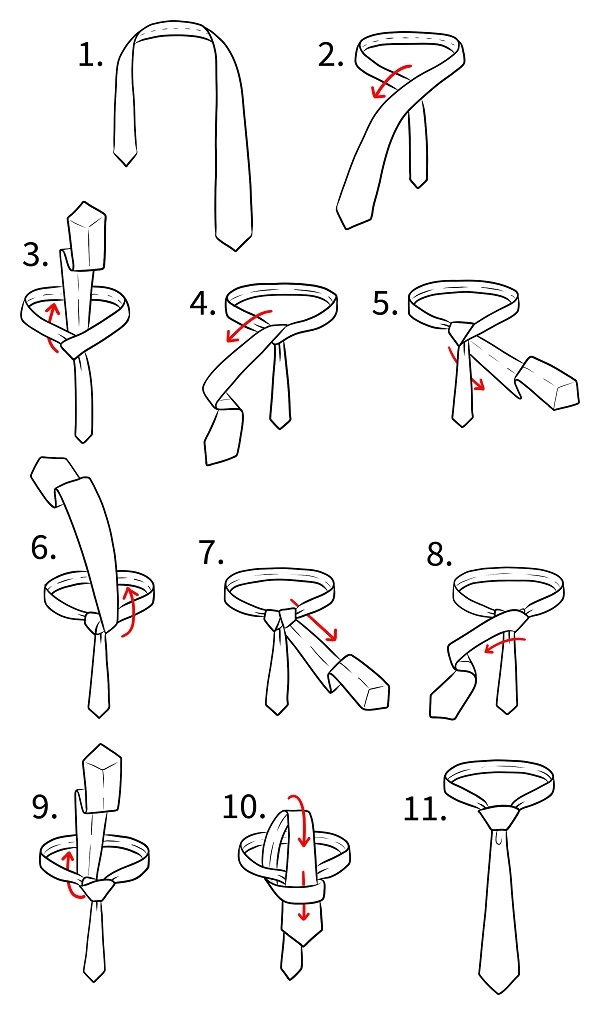 |
Text version - How to tie a Windsor knot
How to tie a Windsor knot
- Start with the wide end of the tie on the right and the short end on the left. The wide end should extend about 30 cms below the narrow end of the tie. This will vary depending on your height and the length and thickness of the tie. Only move the active (wide) end.
- Cross the wide end horizontally in front close to your neck to make an X.
- Bring the wide end up into the neck loop (hole between your neck and tie) from underneath.
- Bring the wide end down to the left.
- Bring the wide end around the back of the small end to the right.
- Bring the wide end up to the center, towards neck loop.
- Bring the wide end through the neck loop and down to the right.
- Bring the wide end across the front to the left.
- Bring the wide end up into the neck loop from underneath.
- Bring the wide end down through the loop you’ve just created in the front.
- Tighten the knot by pulling it at the wide end. Slide the knot up and adjust the knot.
Figure 2-2-9-b - Necktie – Four in Hand Knot |
|---|
 |
Text version - How to tie a Four in Hand knot
How to tie a Four in Hand knot
- Start Position: Drape the tie around your neck with the wide end on your right side and the narrow end on your left side. The wide end should be longer than the narrow end.
- First Cross: Cross the wide end over the narrow end, forming an "X" shape near your collar.
- Wrap Underneath: Bring the wide end under the narrow end and pull it to your right side.
- Second Wrap: Wrap the wide end over the narrow end again, bringing it to your left side.
- Prepare the Knot Loop: Pull the wide end underneath the narrow end near the collar, creating a loop in front of your neck.
- Thread Through the Loop: Pass the wide end through the loop you created in the previous step, pulling it downward.
- Tighten and Adjust: Hold the narrow end with one hand and slide the knot upward toward your collar with the other hand. Adjust the knot until it sits neatly.
Figure 2-2-10 - Lacing Footware |
||
|---|---|---|
Boots, ankle |
Multi-purpose boot |
|
 |
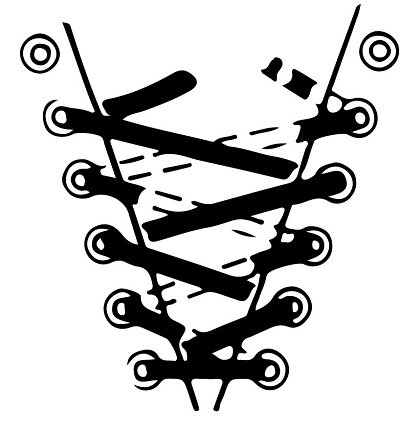 |
 |
Ankle boots. |
Left boot. |
Right boot. |
Text version - How to lace boots
How to lace ankle boots
- Start by going straight across the two bottom eyelets, from outside to inside. Both ends of the lace should be coming out from under the eyelets. Make sure the left and right laces are even in length.
- With the right lace, go straight up to the next eyelet and pull it from the inside to the outside. Then, go through the eyelet directly across to the left, outside to inside.
- With the left lace, go straight up, skipping the eyelet that the right lace is going through, and pull it through the next eyelet, inside to outside. Then, go through the eyelet directly across to the right, outside to inside.
- With the right lace, go straight up, skipping the eyelet that the left lace is going through, and pull it through the next eyelet, inside to outside. Then, go through the eyelet directly across to the left, outside to inside.
- Repeat steps 3 and 4 until you get to the top. If you have an even number of eyelet pairs, you can go right to the top with no problem. If you have an odd number, you’ll get to a point where you can’t continue the pattern. When this happens, cross the lace and go through the next eyelet up, inside to outside (see diagram for example). This cross will hardly be visible once the shoes are tied up, keeping the intended clean look.
How to lace multi-purpose boots - left boot
- Start by going straight across the two bottom eyelets, from outside to inside. Both ends of the lace should be coming out from under the eyelets. Make sure the left and right laces are even in length.
- Thread the left lace across and up one eyelet, going from under the eyelet, then out. Do the same for the opposite lace and repeat until you get to the top.
How to lace multi-purpose boots - right boot
- Start by going straight across the two bottom eyelets, from outside to inside. Both ends of the lace should be coming out from under the eyelets. Make sure the left and right laces are even in length.
- Thread the right lace across and up one eyelet, going from under the eyelet, then out. Do the same for the opposite lace and repeat until you get to the top.